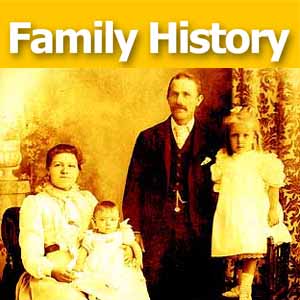Family History Episode 9 – Using Census Records
 Originally published Fall 2008
Originally published Fall 2008
Republished Dec. 3, 2013
Download the Show Notes for this Episode
Welcome to this step-by-step series for beginning genealogists—and more experienced ones who want to brush up or learn something new. I first ran this series in 2008. So many people have asked about it, I’m bringing it back in weekly segments.
Episode 9: Using Census Records
In this episode we start off by talking about a group of records critical to family history research in my home country: U.S. Federal Census Records. You’ll learn not only what to find in the regular schedules, but about the enumerators, the instructions they followed, and special sections like the economic census.
Then in our second segment we go straight to the source: Bill Maury, Chief of History Staff at the U.S. Census Bureau. I’ll be talking to him about the History section of the Census Department’s website. Note the updated Genealogy tab on the site, as well as the Through the Decades tab, which is packed with historical information for each census.
Updates
Since the show first aired, the 1940 U.S. Census has become publicly available. This was the largest, most comprehensive census taken, with over 132 million names of those known as the “greatest generation.” Full indexes and images are available at several sites. Your first stop should be the National Archives’ official 1940 census website to learn about the census itself. Then search it at your favorite genealogy data site in one of the links below.
Finally, I gave you specific instructions in the podcast on searching the 1930 U.S. Census online at Ancestry.com. To specifically search any of the U.S. censuses (or any other record collection) at Ancestry.com, go to the Search tab and select Card Catalog. You’ll see several censuses among the options they give you, or you can enter keywords like “1940 census.”
Links
Search U.S. censuses online at:
OR Learn more about researching from microfilm at the National Archives website.
Genealogy Gems Podcast Episode 258 DNA Problem Solving
DNA Problem Solving Strategies for Genealogy
Listen to Genealogy Gems Podcast Episode 258
To Listen click the media player below (AUDIO ONLY):
Watch the Original Video
This audio comes from my YouTube video series Elevenses with Lisa episode 44. You can watch the video interview at the Elevenses with Lisa episode 44 show notes page.
Get $10 off StoryWorth
Genealogy Gems Premium Members Exclusive Download:
Log into your Premium membership and then click here to download the handy PDF show notes that compliment this podcast episode.
Become a Genealogy Gems Premium Member
Premium Members have exclusive access to:
- Video classes and downloadable handouts
- The Genealogy Gems Premium Podcast
- Elevenses with Lisa downloadable ad-free show notes PDF cheat sheets
Become a member here.
Genealogy Gems Podcast App
Don’t miss the Bonus audio for this episode. In the app, tap the gift box icon just under the media player. Get the app here.
Get the Free Genealogy Gems Newsletter
The Genealogy Gems email newsletter is the best way to stay informed about what’s available with your Premium eLearning Membership. Sign up today here.
Our Sponsor:
MyHeritage: Click here to start finding your family history at MyHeritage

MyHeritage.com is the place to make connections with relatives overseas, particularly with those who may still live in your ancestral homeland.
Follow Lisa and Genealogy Gems on Social Media:
- Instagram.com/genealogygemspodcast
- Facebook.com/genealogygems
- Pinterest.com/lisalouisecooke
- YouTube.com/GenealogyGems
Podcast Resources
Researching to write a family history narrative
Dale Spaulding discovered remarkable stories when he was researching his family for over 30 years. But he got a little worried that these really uniquely American stories were going to be lost to time if he didn’t do something about it. Maybe you have some of those same fears. It was his determination to preserve that family history that was really the driving force behind why he sat down and wrote a book about it. It’s called Fortitude, Preserving 400 years of an American Family’s Faith, Patriotism, Grit, and Determination. (This affiliate link helps support this free content.)
Dale joins me to share how he went about getting started researching his family tree to prepare to write his narrative. He also shares what motivates him to keep on researching.
Watch the Video
Show Notes
Downloadable ad-free Show Notes handout for Premium Members.
What is a Family History Narrative
- Creative Nonfiction
- More than Genealogy Names/Dates
- Stories about your Ancestor’s Lives
- Begin with Dramatic Event (Leaving the Old Country)
- Project Entails Exhaustive Research
- The Why? Legacy to Pass to My Descendants
Getting Started in Research
- Nail Down the Genealogy Data
- Caution on Ancestry.com
- FindaGrave.com
- Seek Corroborative Record Evidence
- Meticulous Documentation – Source Notes (Watch Source Citation for Genealogy)
- Become a Student of History
Research Tips
- Stories from Aging Relatives
- Town History Books
- Local Librarians
- Newspapers.com and Fold3.com (Watch Digging Deeper at Newspapers.com)
- Small Town Halls
- National Archives (Watch How to Search the U.S. National Archives Online Catalog for Genealogy)
- Census Records
- Facebook Groups: New England Genealogy
- Put on Your Detective Hat (Premium Members Watch Genealogical Cold Cases: A Step-by-Step Process.)
About Dale Spaulding
Dale R. Spaulding is a lifelong student of history. He’s discovered remarkable stories of his family’s long and rich past during thirty-plus years of research. Concerned that these uniquely American stories would be lost to time, he was determined to preserve them for generations to follow – one of the reasons he authored Fortitude: Preserving 400 Years of an American Family’s Faith, Patriotism, Grit and Determination.

Dale Spaulding, Author of Fortitude
During his career, Dale navigated the oceans and seas of the world in his twenty-two years of service in the U.S. Navy retiring as a Lieutenant Commander. Following the Navy, he was a software quality engineer and technical fellow at The Boeing Company. Dale then served as director of a national church planting organization.
Dale is a graduate of Auburn University and the U.S. Naval Postgraduate School. Now retired, Dale and his wife Nancy reside in Virginia and they have two sons and four grandchildren. He is passionate about his faith, his family and his country.
Visit Dales website: https://dalespaulding.com
Resources
Downloadable ad-free Show Notes handout for Premium Members.
Stay tuned for upcoming videos on Dale’s writing process.
More Videos & Show Notes:
- Reconstructing Your Family’s Amazing Stories (Premium)
- Share Your Life Story in a More Meaningful Way (Premium)

